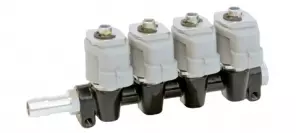- Main page
- Search
- Up to date
- Products
- Technology
- Vehicles
- Video
- Conversion Payback Simulator
Port Injection - Conversion Payback Simulator
Direct Injection - Conversion Payback Simulator
Diesel - Newsletter
Rail IG7 Dakota - the versatile one
 loading results...
loading results... © RailYou've seen one injector rail, you've seen them all - it's specs and parameters that really matter
© RailYou've seen one injector rail, you've seen them all - it's specs and parameters that really matterNo mountain too high
Currently produced cars are motivated by engines with 2-16 cylinders. In theory, nearly all of them can be converted to run on LPG instead of petrol, but in practice there are hardly any two-pots and the only actual passenger vehicles that feature 16-cylinder powerplants are Bugatti's Veyron and Chiron hypercars – machines that don't get converted to gaseous fuel power all that often. Or ever, for that matter. But since cars with 3-12 cylinders are regulars at conversion shops (vast majority of them being 4- and 6-pots), Rail developed 2-, 3- and 4-injector rail versions of the IG7 Dakota to cover all the market.
Mix and match
Since there are virtually no two-cylinder engines out there, what's the point in offering two-injector rails? Well, for one thing there are some five-cylinder units available (not many of them and limited almost exclusively to Volkswagen and Audi applications, but still...), for another sometimes it may be more convenient to use three two-injector rails than two three-injector ones while converting a six-cylinder unit. Three- and four-injector versions are more typical, allowing to convert anything featuring 3, 4, 6 or 8 cylinders. But enough mixing and matching, let's have a closer look at the newcomer.
Cut out for the job
IG7 Dakota rails feature aluminium bodies (for improved heat transfer) and, according to the manufacturer, offer high speed performance (opening/closing times are 1,7/1,4 ms at 0,47 mm piston stroke, which is adjustable) and durability, combined with improved flow stability and repetitiveness. It's also insensitive to dirt accumulation, repairable and very sturdy. Seems like the new product is well prepared to fare well in the market, but – as usual – we'll have to wait and see.
You may also find these interesting:
 loading results...
loading results...








